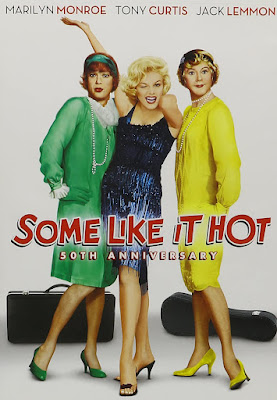It’s as old as Shakespeare: a man dressing up in women’s clothing. Of course in Shakespeare’s day there was an added complication. Because rules of public morality determined that it would be indecent to have a woman in a theatre troupe, young men put on dresses and wigs to play all the female roles. This helps explain why in so many Shakespearean comedies (like Twelfth Night and As You Like It) female characters spend much of their time in male disguise. The resulting gender confusion was explored by Tom Stoppard and company in one of my favorite romantic films, Shakespeare in Love. In that 1998 Best Picture winner, the theatre-mad Viola de Lesseps (Gwyneth Paltrow) disguises herself as a male—complete with a tiny mustache—so she can audition to join Shakespeare’s acting company. She ultimately originates the role of Juliet while having a doomed affair with the playwright himself.
Usually, on stage and in movies, it’s men dressing up as women. Even long after actresses were accepted on stage, the British have continued to love the buffoonish spectacle of a well-padded man tricked out in a woman’s petticoat and bonnet. The so-called “dame show” has been a holiday staple for hundreds of years. Clearly it was this tradition that inspired Ray Bolger’s starring role in the hit musical version of a popular stage farce, Charley’s Aunt, in which a young man tries to further his romantic goals by disguising himself as a visiting dowager. The British original, which debuted back in 1892, was ultimately filmed at least 13 times, in productions all over the world. No one, it seems, could get enough of a guy sporting a flouncy skirt.
In 1959, Billy Wilder and I.A.L.Diamond updated the “dame show” tradition by combining it with a gangster thriller in Some Like It Hot. In this beloved comedy, two musicians played by Tony Curtis and Jack Lemmon accidentally witness the St. Valentine’s Day Massacre. Desperate to escape detection, they disguise themselves as women and join an all-girl band en route from Chicago to Miami Beach. Their masquerade involves the usual men-dressed-as-women tropes, as they wobble in high heels and struggle to project coy feminine charm. But the two authors add their own hilarious touches, as Curtis takes on a second identity (that of a grieving millionaire who’s lost his sex drive) in order to woo band singer Marilyn Monroe, while Lemmon somehow finds himself engaged to marry dingbat tycoon Joe E. Brown.
Twenty-three years later, Larry Gelbart and some others put a new theatrical spin on the man-in-woman’s-clothing comedy. The film was Tootsie: its central character, Michael Dorsey—played by Dustin Hoffman—is a talented but pugnacious stage actor who’s burned so many bridges that he can only land an acting job by trying on a new gender. As Dorothy Michaels, he lands a gig on a soap opera, quickly becoming a fan favorite. Tootsie is full of subtle commentary on how women are treated, as Michael’s attitudes evolve while his fanbase grows.
Then (sigh) there’s 1993’s Mrs. Doubfire, in which Robin Williams, faced with losing his children to divorce, gets the bright idea of turning himself into a cozy British nanny in order to be near them. Completely fooling his ex-wife and everyone else, he manages to prove that he’s indispensable to the happy running of their household. I tried watching this on a recent plane flight, and found the playing out of this family story grotesque in its reliance on crude gender stereotypes. A dad as Mr. Mom showing off a D-cup? Yuck.





No comments:
Post a Comment